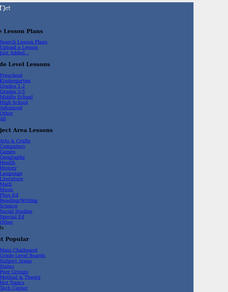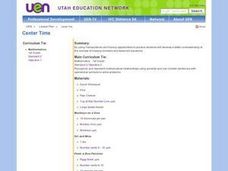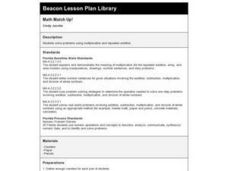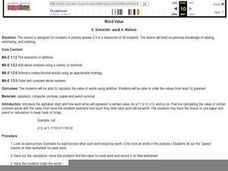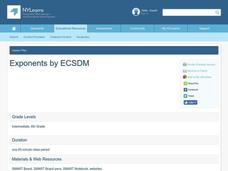Curated OER
The Language of Mathematics
Students integrate the language, concepts and skills of math into the daily routine and classroom environment. They think mathematically by participating in short, daily, individual, small group, whole group and transitional activities...
Curated OER
Ws and Worms
Students explore problem solving strategies. Given real life problems, students examine the sum of consecutive strings of whole numbers. Students use diagrams and sequencing to solve problems. Students justify their mathematical...
Helping with Math
Multiplication: 2-digit x 2-digit
Number crunchers sharpen their math skills as they solve 30 problems requiring them to multiply two-digit numbers by two-digit numbers. Assign this as homework or use it as an assessment after practicing the skill together in class.
Curated OER
Value Your Digits
Third graders work with place value. In this place value lesson, 3rd graders write three digit numbers and tell the place value of each number. They compare numbers and money, regroup, discuss the value of coins, and count money.
Curated OER
Multiplication With Decimals
In this multiplying decimals worksheet, students solve 24 multiplication problems. Each problem has a decimal being multiplied by a two or three-digit number.
Curated OER
Cell Discoveries
Students observe, compare and describe cell organelles in terms of their function, structure and operation. They enter and edit information in a database, build and sort a student-designed database and find records in a database.
Curated OER
T-Shirt Lettering
Students determine the cost of a t-shirt using a variety of mathematical operations to solve problems. Then they use a spreadsheet to calculate the cost of lettering a t-shirt and display this information in a graph.
Curated OER
Balloon Rockets
Students, after reviewing and analyzing Newton's third law of motion, make balloon rockets and experiment with a variety of models. After the experiment, they chart the results and form conclusions. In addition, they compare/contrast...
Curated OER
Center Time
First graders recognize and represent mathematical relationships using symbols and use number sentences with operational symbols to solve problems. They complete various activities such as tug of war, monkeys on a vine, and hit and miss....
Curated OER
Binary Math Circuits
In this electronics learning exercise, students perform mathematical operations using binary circuits to answer 11 questions. They explain and analyze schematic diagrams given.
Curated OER
Adding and Subtracting Polynomials Using Algebra Tiles
Students add and subtract polynomials. In this algebra lesson, students use algebra tiles to perform operation of polynomials. They model their problems and understand how to combine like terms using tiles.
Curated OER
Rounding to the Nearest Ten
For this rounding worksheet, students complete the thought process sentences and round numbers to the nearest ten. Students round twenty-four problems.
Curated OER
Dividing by 4's
Third graders explore math functions by completing problem solving activities. In this division instructional activity, 3rd graders utilize the division strategies acquired earlier to divide multiple digit numbers by 4's. Students...
Curated OER
Designing a Space Station
Students view pictures of the space station and discuss their feelings about living in a space station. They discuss the materials needed to build a space station and its various needs for operation. They read the NASA contest rules...
Curated OER
Gulls
Students listen to the problem and think about the first question and the number operation that they would use and explain. They work in pairs and record their solutions so that they can be displayed and shared.
Curated OER
Division Cookies
Fifth graders demonstrate the concept of division through sharing concrete objects. They divide cookies into parts and recreate a whole by sharing their pieces with the group. Students request cookies during a small group actvity using I...
US National Archives
WWII: Mediterranean and N. Africa 1939-45 – Where Will the Allies Invade?
An interactive asks learners to act as German intelligence agents and examine documents found on the body of an English soldier wash ashore on the cost of Spain. Using the documents, the agents are asked to predict where the Allies were...
Pennsylvania Department of Education
Problem Solving by Using Multiplication to Solve Division Problems
Learners use index cards, counting cubes, and their own understanding to identify how division problems can be solved by using multiplication. In this division lesson plan, students use their multiplication skills to solve division...
Curated OER
Number Sentences
Fifth graders become familiar with problem solving strategies of guess and check and working backwards. They demonstrate the basic concepts of addition, subtraction, multiplication, and division using a math sentence.
Curated OER
Math Match Up!
Help learners solve problems using multiplication and repeated addition. Using counters, learners will be paired up to solve problems. They will go through a series of questions and show models with the counters for the solution. Then...
Curated OER
"How Many Names for 100?"
Fifth graders work on the different possibilities of reaching the number 100. The class is divided into homogeneous groups for cooperative learning. The lesson uses discussion questions to help with problem solving.
Curated OER
Teddy Bears and Friends
Children begin by making direct comparisons between objects and putting a number of objects into order according to length. They are also introduced to measuring with multi-link cubes which allows them to compare objects which cannot be...
Curated OER
Word Value
Students investigate the concepts of adding, estimating, and ordering. The instructional activity uses the alphabet as an example illustration. The students practice the calculations in class in order to ensure mastery.
Curated OER
Exponents
Students recognize the proper use of exponents in mathematical expressions. They calculate expressions with the intention of comprehension of the principle of repeated factors can be expressed as powers.








